High-Sensitivity and Wide-Range Flexible Ionic Piezocapacitive Pressure Sensors with Porous Hemisphere Array Electrodes
Abstract
:1. Introduction
2. Experimental Section
2.1. Materials
2.2. Fabrication of the Capacitive Pressure Sensor
2.3. Characterization and Measurement
2.4. Calculations
3. Results and Discussion
3.1. Formation Mechanism of Porous Hemispherical Structure on PDMS
3.2. Sensing Mechanism of Sensor
3.3. Sample Morphology
3.4. Mechanical Simulation of PDMS Film with Hemispherical Array
3.5. Sensing Characterization of the Sensor
3.6. Application of the Sensor
4. Conclusions
Author Contributions
Funding
Institutional Review Board Statement
Informed Consent Statement
Data Availability Statement
Conflicts of Interest
References
- Xu, C.; Mei, D.; Zhu, L.; Wang, Y. Flexible capacitive pressure sensor array using acoustic-assisted fabrication of microstructures as surface and dielectric layers. Sens. Actuators A Phys. 2022, 348, 114006. [Google Scholar] [CrossRef]
- Zeng, Y.; Qin, Y.; Yang, Y.; Lu, X. A low-cost flexible capacitive pressure sensor for health detection. IEEE Sens. J. 2022, 22, 7665–7673. [Google Scholar] [CrossRef]
- Duan, Z.; Yuan, Z.; Jiang, Y.; Zhao, Q.; Huang, Q.; Zhang, Y.; Liu, B.; Tai, H. Power generation humidity sensor based on primary battery structure. Chem. Eng. J. 2022, 446, 136910. [Google Scholar] [CrossRef]
- Zhu, P.; Kuang, Y.; Wei, Y.; Li, F.; Ou, H.; Jiang, F.; Chen, G. Electrostatic self-assembly enabled flexible paper-based humidity sensor with high sensitivity and superior durability. Chem. Eng. J. 2021, 404, 127105. [Google Scholar] [CrossRef] [PubMed]
- Liang, B.; Cao, Q.; Mao, X.; Pan, W.; Tu, T.; Fang, L.; Ye, X. An integrated paper-based microfluidic device for real-time sweat potassium monitoring. IEEE Sens. J. 2021, 21, 9642–9648. [Google Scholar] [CrossRef]
- Li, M.; Wang, L.; Liu, R.; Li, J.; Zhang, Q.; Shi, G.; Li, Y.; Hou, C.; Wang, H. A highly integrated sensing paper for wearable electrochemical sweat analysis. Biosens. Bioelectron. 2021, 174, 112828. [Google Scholar] [CrossRef] [PubMed]
- Tang, Y.; Zhong, L.; Wang, W.; He, Y.; Han, T.; Xu, L.; Mo, X.; Liu, Z.; Ma, Y.; Bao, Y.; et al. Recent advances in wearable potentiometric Ph sensors. Membranes 2022, 12, 504. [Google Scholar] [CrossRef]
- Mazzara, F.; Patella, B.; D’Agostino, C.; Bruno, M.G.; Carbone, S.; Lopresti, F.; Aiello, G.; Torino, C.; Vilasi, A.; O’Riordan, A.; et al. Pani-based wearable electrochemical sensor for Ph sweat monitoring. Chemosensors 2021, 9, 169. [Google Scholar] [CrossRef]
- Chen, L.; Chang, X.; Wang, H.; Chen, J.; Zhu, Y. Stretchable and transparent multimodal electronic-skin sensors in detecting strain, temperature, and humidity. Nano Energy 2022, 96, 107077. [Google Scholar] [CrossRef]
- Wu, Z.; Ding, H.; Tao, K.; Wei, Y.; Gui, X.; Shi, W.; Xie, X.; Wu, J. Ultrasensitive, stretchable, and fast-response temperature sensors based on hydrogel films for wearable applications. ACS Appl. Mater. Interfaces 2021, 13, 21854–21864. [Google Scholar] [CrossRef]
- Hong, Y.J.; Jeong, H.; Cho, K.W.; Lu, N.; Kim, D. Wearable and implantable devices for cardiovascular healthcare: From monitoring to therapy based on flexible and stretchable electronics. Adv. Funct. Mater. 2019, 29, 1808247. [Google Scholar] [CrossRef]
- Liu, X.; Miao, J.; Fan, Q.; Zhang, W.; Zuo, X.; Tian, M.; Zhu, S.; Zhang, X.; Qu, L. Recent progress on smart fiber and textile based wearable strain sensors: Materials, fabrications and applications. Adv. Fiber Mater. 2022, 4, 361–389. [Google Scholar] [CrossRef]
- Zhu, J.; Xue, X.; Song, Y.; Wu, C.; Mao, Q. A flexible and robust double-helix tubular cloth/carbon fibers piezoresistive sensor for human motion detecting. Mater. Lett. 2022, 318, 132212. [Google Scholar] [CrossRef]
- Lei, X.; Ma, L.; Yu, S.; Ren, T.; Li, S.; Yuan, J.; Liu, F. Ultrahigh sensitive, sensing-actuating integrated, and multi-functional intelligent skin based on electromechanical-hydraulic coupling. Chem. Eng. J. 2023, 454, 140548. [Google Scholar] [CrossRef]
- Yu, J.; Xian, S.; Zhang, Z.; Hou, X.; He, J.; Mu, J.; Geng, W.; Qiao, X.; Zhang, L.; Chou, X. Synergistic piezoelectricity enhanced BaTiO3/Polyacrylonitrile elastomer-based highly sensitive pressure sensor for intelligent sensing and posture recognition applications. Nano Res. 2023, 16, 5490–5502. [Google Scholar] [CrossRef]
- Liu, G.; Chen, X.; Li, X.; Wang, C.; Tian, H.; Chen, X.; Nie, B.; Shao, J. Flexible, equipment-wearable piezoelectric sensor with piezoelectricity calibration enabled by in-situ temperature self-sensing. IEEE Trans. Ind. Electron. 2022, 69, 6381–6390. [Google Scholar] [CrossRef]
- Mishra, R.B.; El-Atab, N.; Hussain, A.M.; Hussain, M.M. Recent progress on flexible capacitive pressure sensors: From design and materials to applications. Adv. Mater. Technol. 2021, 6, 2001023. [Google Scholar] [CrossRef]
- Zhang, S.; Wang, L.; Luo, Y.; Wang, K.; Feng, X.; Pei, Y.; Wu, H.; Li, Y.; Wang, Z.; Lu, B. A convenient, low-cost graphene UV-cured additive manufacturing electronic process to achieve flexible sensors. Chem. Eng. J. 2023, 451, 138521. [Google Scholar] [CrossRef]
- Zammali, M.; Liu, S.; Yu, W. A Flexible, transparent, ultralow detection limit capacitive pressure sensor. Adv. Mater. Interfaces 2022, 9, 2200015. [Google Scholar] [CrossRef]
- Zhong, Y.; Wang, J.; Han, L.; Dai, S.; Zhu, H.; Hua, J.; Cheng, G.; Ding, J. High-performance flexible self-powered triboelectric pressure sensor based on chemically modified micropatterned PDMS film. Sens. Actuators A Phys. 2023, 349, 114013. [Google Scholar] [CrossRef]
- Zhao, L.; Zou, H.; Wei, K.; Zhou, S.; Meng, G.; Zhang, W. Mechanical Intelligent Energy Harvesting: From Methodology to Applications. Adv. Energy Mater. 2023, 13, 2300557. [Google Scholar] [CrossRef]
- Cho, C.; Kim, D.; Lee, C.; Oh, J.H. Ultrasensitive ionic liquid polymer composites with a convex and wrinkled microstructure and their application as wearable pressure sensors. ACS Appl. Mater. Interfaces 2023, 15, 13625–13636. [Google Scholar] [CrossRef] [PubMed]
- Ma, L.; Shuai, X.; Hu, Y.; Liang, X.; Zhu, P.; Sun, R.; Wong, C. A highly sensitive and flexible capacitive pressure sensor based on a micro-arrayed polydimethylsiloxane dielectric layer. J. Mater. Chem. C 2018, 6, 13232–13240. [Google Scholar] [CrossRef]
- Yang, J.C.; Kim, J.O.; Oh, J.; Kwon, S.Y.; Sim, J.Y.; Kim, D.W.; Choi, H.B.; Park, S. Microstructured porous pyramid-based ultrahigh sensitive pressure sensor insensitive to strain and temperature. ACS Appl. Mater. Interfaces 2019, 11, 19472–19480. [Google Scholar] [CrossRef] [PubMed]
- Lv, C.; Tian, C.; Jiang, J.; Dang, Y.; Liu, Y.; Duan, X.; Xie, M. Ultrasensitive linear capacitive pressure sensor with wrinkled microstructures for tactile perception. Adv. Sci. 2023, 10, 2206807. [Google Scholar] [CrossRef] [PubMed]
- Li, L.; Zhu, G.; Wang, J.; Chen, J.; Zhao, G.; Zhu, Y. A flexible and ultrasensitive interfacial iontronic multisensory sensor with an array of unique “cup-shaped” microcolumns for detecting pressure and temperature. Nano Energy 2023, 105, 108012. [Google Scholar] [CrossRef]
- Chen, H.; Guo, D.; Lei, X.; Wu, W.; Guo, X.; Li, Y.; Liu, F. One-step laser direct-printing process of a hybrid microstructure for highly sensitive flexible piezocapacitive sensors. ACS Appl. Mater. Interfaces 2023, 15, 21435–21443. [Google Scholar] [CrossRef]
- Chen, J.; Li, L.; Zhu, Z.; Luo, Z.; Tang, W.; Wang, L.; Li, H. Bioinspired design of highly sensitive flexible tactile sensors for wearable healthcare monitoring. Mater. Today Chem. 2022, 23, 100718. [Google Scholar] [CrossRef]
- Xu, J.; Li, H.; Yin, Y.; Li, X.; Cao, J.; Feng, H.; Bao, W.; Tan, H.; Xiao, F.; Zhu, G. High sensitivity and broad linearity range pressure sensor based on hierarchical in-situ filling porous structure. NPJ Flexble Electron. 2022, 6, 62. [Google Scholar] [CrossRef]
- Zhao, T.; Li, T.; Chen, L.; Yuan, L.; Li, X.; Zhang, J. Highly sensitive flexible piezoresistive pressure sensor developed using biomimetically textured porous materials. ACS Appl. Mater. Interfaces 2019, 11, 29466–29473. [Google Scholar] [CrossRef]
- Long, Y.; Zhao, X.; Jiang, X.; Zhang, L.; Zhang, H.; Liu, Y.; Zhu, H. A porous graphene/polydimethylsiloxane composite by chemical foaming for simultaneous tensile and compressive strain sensing. FlatChem 2018, 10, 1–7. [Google Scholar] [CrossRef]
- Huang, W.; Dai, K.; Zhai, Y.; Liu, H.; Zhan, P.; Gao, J.; Shen, C. Flexible and lightweight pressure sensor based on carbon nanotube/thermoplastic polyurethane-aligned conductive foam with superior compressibility and stability. ACS Appl. Mater. Interfaces 2017, 9, 42266–42277. [Google Scholar] [CrossRef] [PubMed]
- Zhao, Y.; Lei, X.; Xu, J.; Li, Y.; Wu, W.; Guo, X.; Liu, F. High-performance porous PDMS-based piezoresistive sensor prepared by a modified microwave irradiation process. ACS Appl. Electron. Mater. 2022, 4, 5498–5505. [Google Scholar] [CrossRef]
- Luo, Y.; Chen, X.; Tian, H.; Li, X.; Lu, Y.; Liu, Y.; Shao, J. Gecko-inspired slant hierarchical microstructure-based ultrasensitive iontronic pressure sensor for intelligent interaction. Research 2022, 2022, 9852138. [Google Scholar] [CrossRef]
- Zhang, C.; Zhou, W.; Geng, D.; Bai, C.; Li, W.; Chen, S.; Xie, Y. Laser direct writing and characterizations of flexible piezoresistive sensors with microstructures. Opto-Electron. Adv. 2021, 4, 200061. [Google Scholar] [CrossRef]
- Guo, X.; Ma, L.; Wu, W.; Li, S.; Lei, X.; Wu, X.; Liu, F. Ultra-sensitive flexible piezoresistive pressure sensor prepared by laser-assisted copper template for health monitoring. Sens. Actuators A Phys. 2022, 334, 113325. [Google Scholar] [CrossRef]
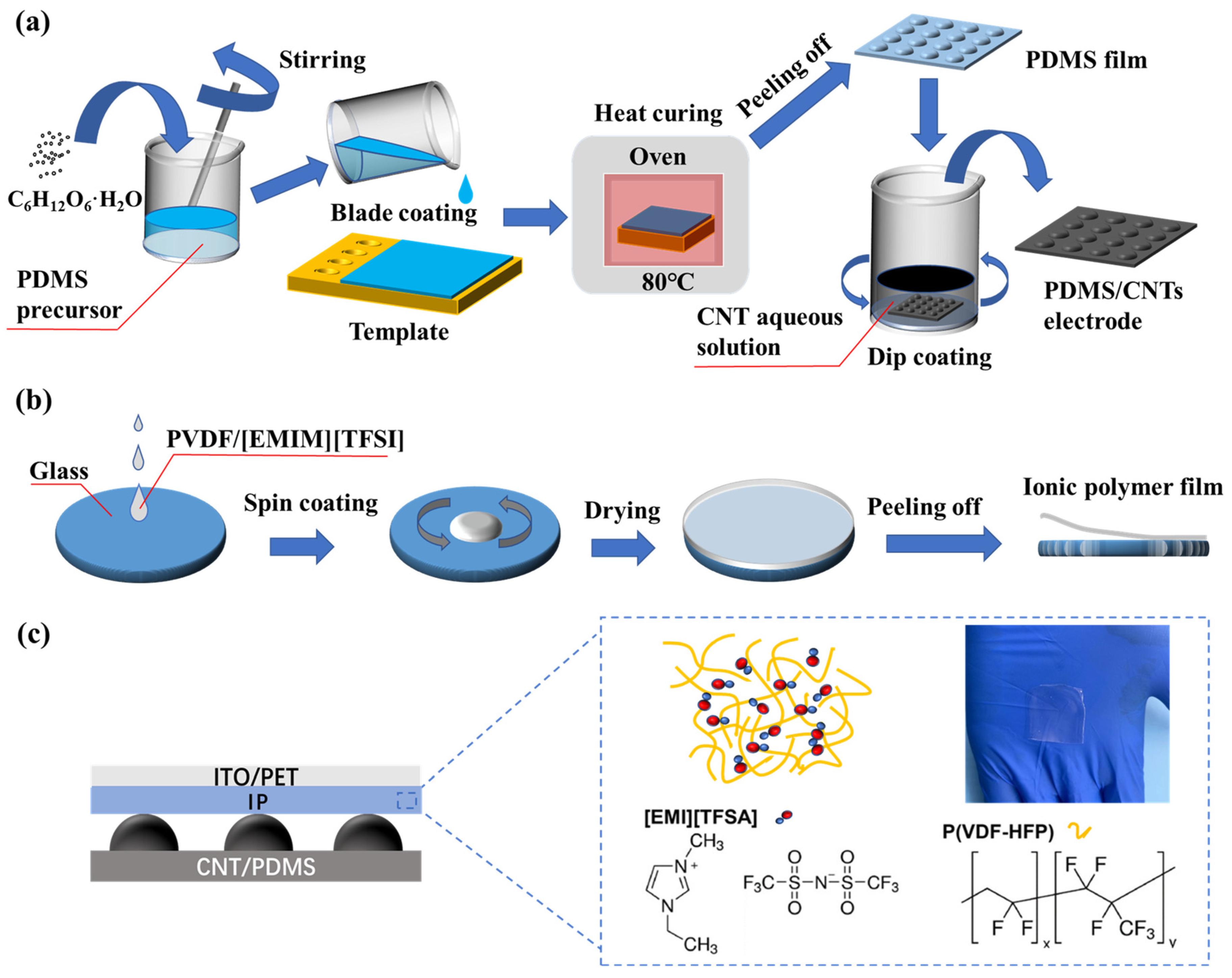
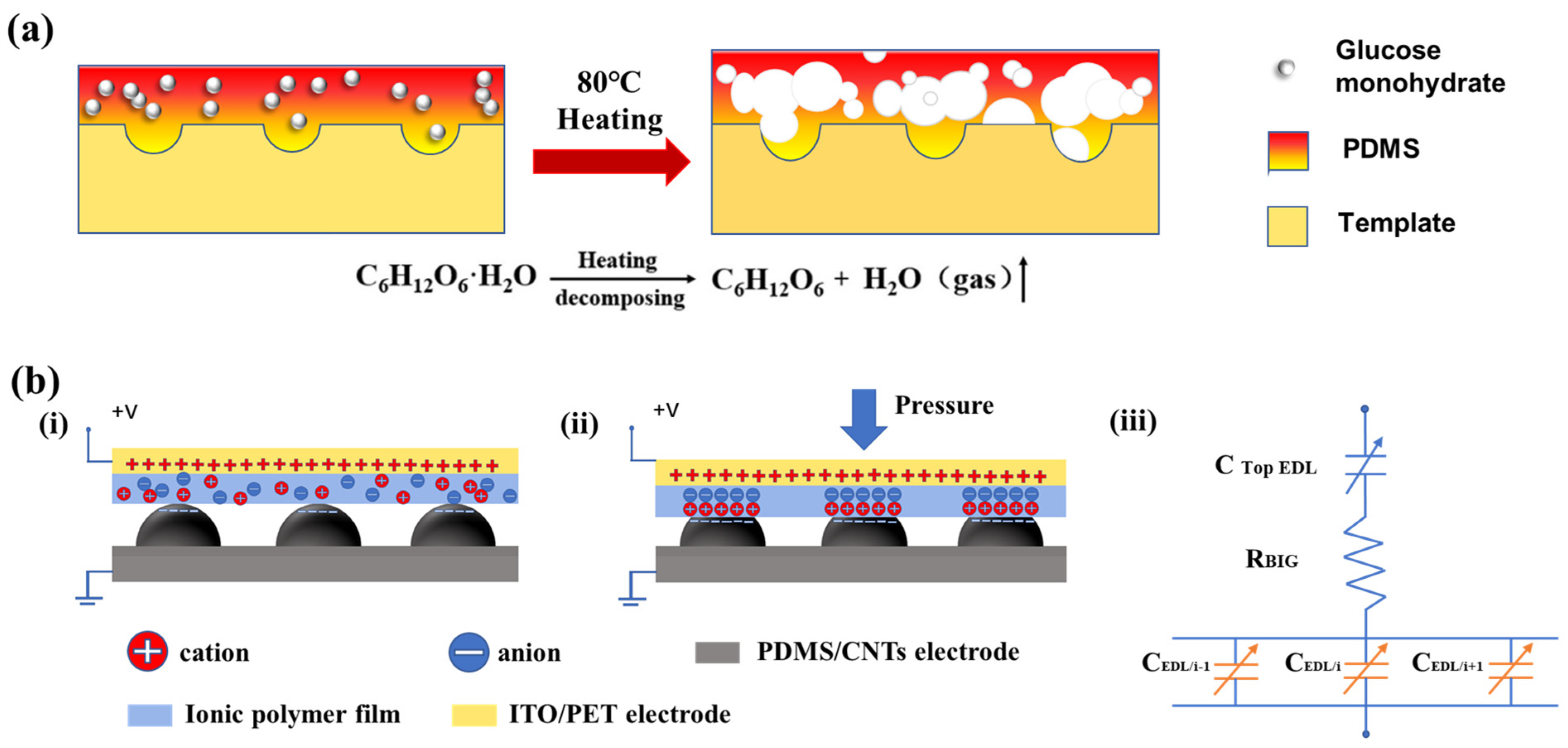
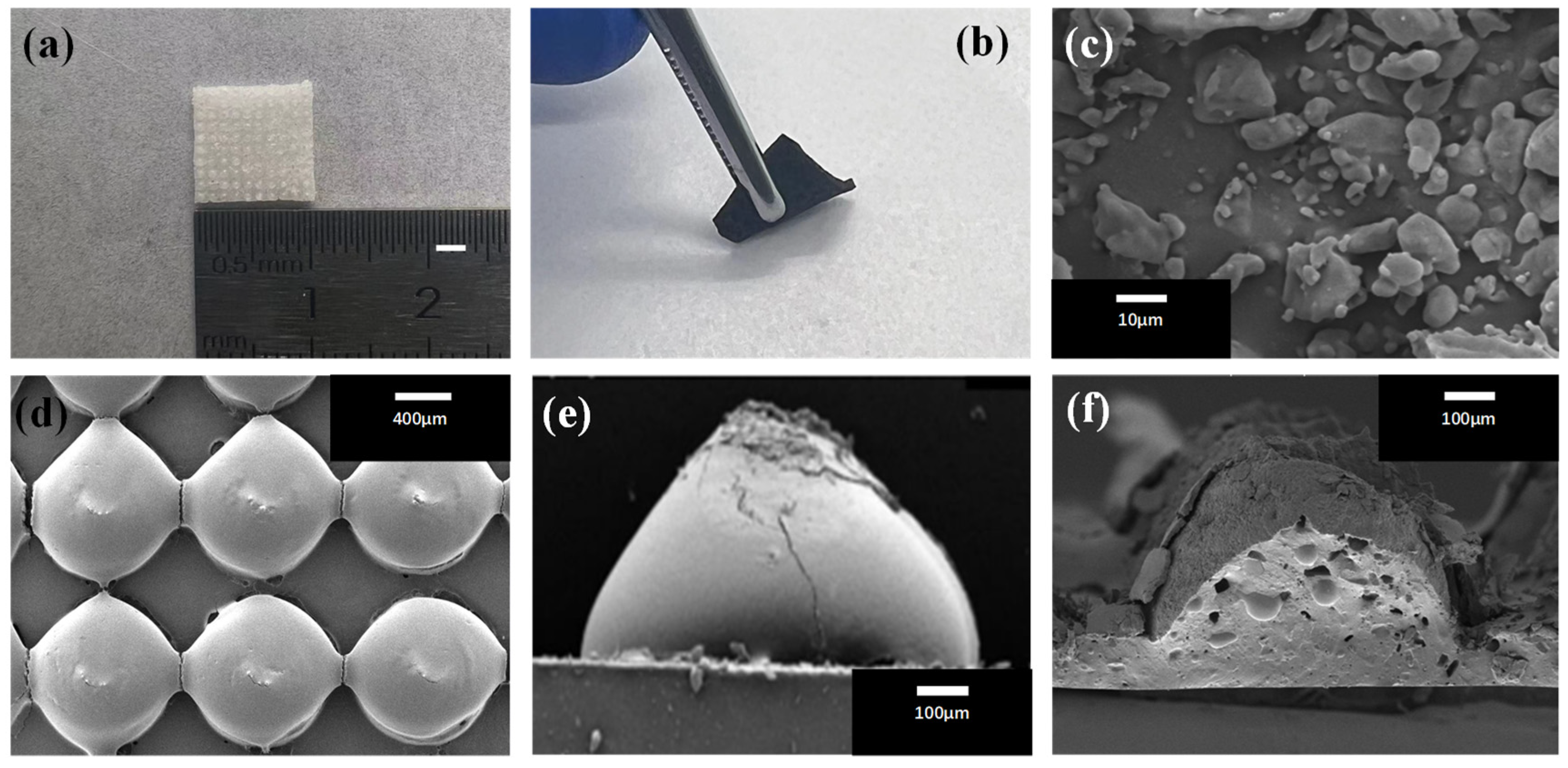

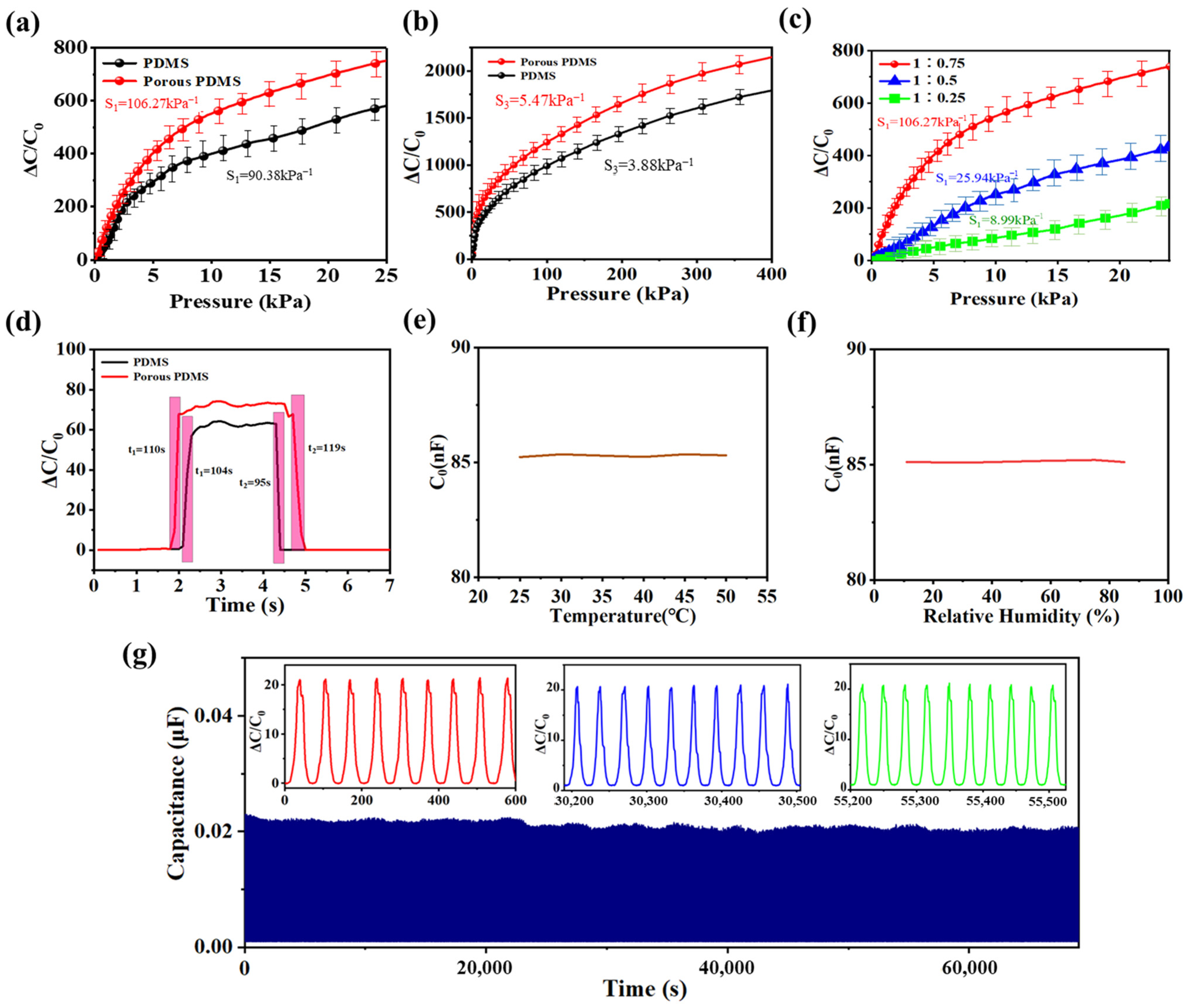
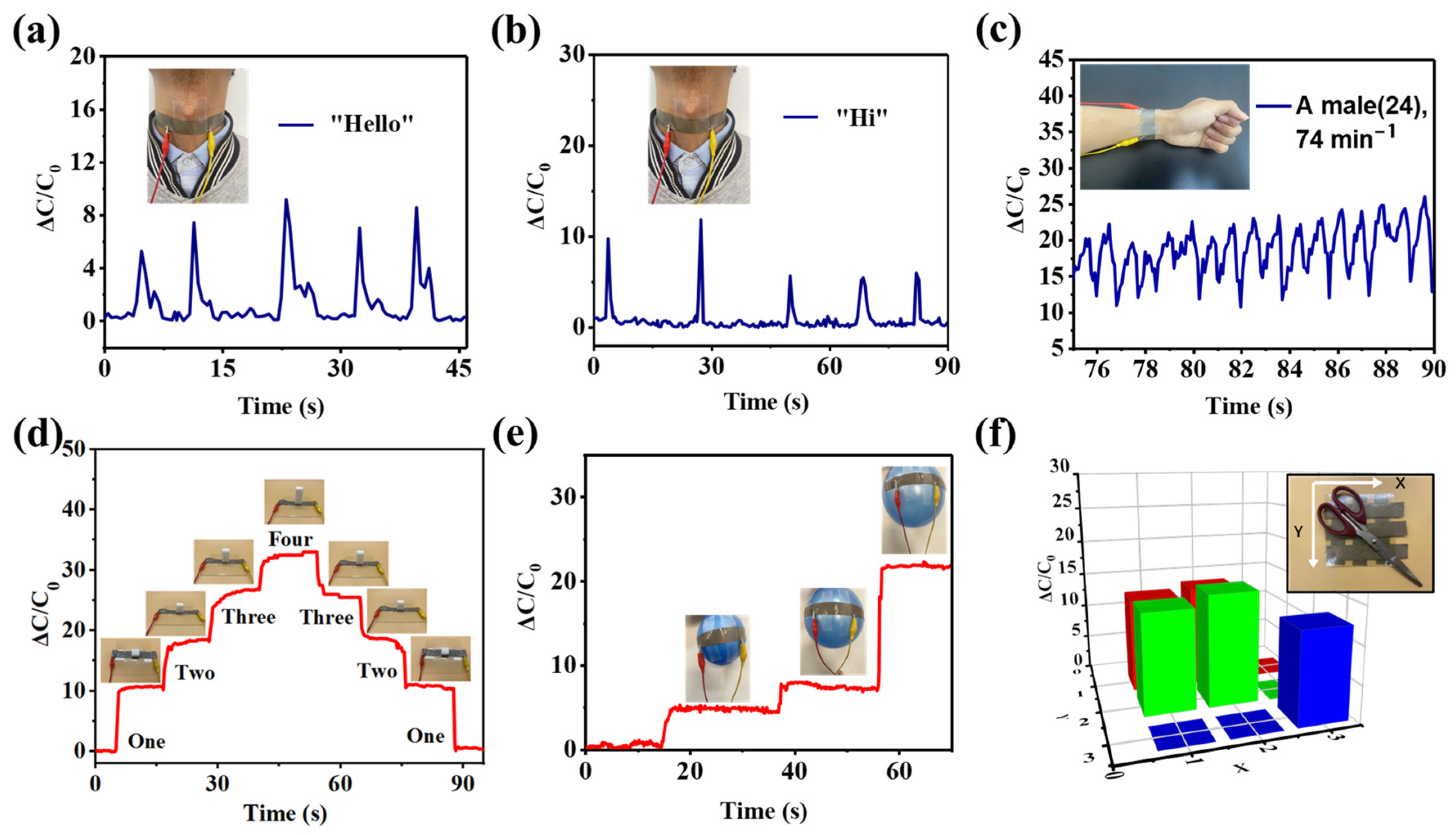
| Electrode | Dielectric Layer | Sensitivity | Sensing Range | Response/Recovery Time | Ref. |
|---|---|---|---|---|---|
| aluminum foil | PVA/KOH/KI/glycerol | 0.3199 | 0.1 kPa–65 kPa | 80 ms/55 ms | [2] |
| AgNWs/PDMS | PDMS | 2.04 kPa−1 | 0 Pa–9 kPa | 100 ms/100 ms | [23] |
| ITO/PET | MWCNT/PDMS | 1.448 Pa−1 | 0 Pa–20 kPa | 123 ms/86 ms | [25] |
| AgNWs/PDMS | [EMIM][TFSI]/PVDF-HFP | 37.8 kPa−1 | 24 Pa–90 kPa | 78 ms/47 ms | [29] |
| Al Fabric | [EMIM][TFSI]/ PVDF-HFP/PDMS | 56.91 kPa−1 | 0 kPa–80 kPa | 60 ms/50 ms | [30] |
| MXene/ nonwoven fabric | [EMIM][TFSI]/PVDF-HFP | 31.40 kPa−1 | 0 kPa–80 kPa | 45 ms/45 ms | [32] |
| CNTs/PDMS | [EMIM][TFSI]/PVDF-HFP | 106.27 kPa−1 | 0 kPa–400 kPa | 110 ms/119 ms | This work |
Disclaimer/Publisher’s Note: The statements, opinions and data contained in all publications are solely those of the individual author(s) and contributor(s) and not of MDPI and/or the editor(s). MDPI and/or the editor(s) disclaim responsibility for any injury to people or property resulting from any ideas, methods, instructions or products referred to in the content. |
© 2024 by the authors. Licensee MDPI, Basel, Switzerland. This article is an open access article distributed under the terms and conditions of the Creative Commons Attribution (CC BY) license (https://creativecommons.org/licenses/by/4.0/).
Share and Cite
Wu, B.; Wu, W.; Ma, R.; Chen, H.; Zhao, Y.; Li, Y.; Lei, X.; Liu, F. High-Sensitivity and Wide-Range Flexible Ionic Piezocapacitive Pressure Sensors with Porous Hemisphere Array Electrodes. Sensors 2024, 24, 366. https://doi.org/10.3390/s24020366
Wu B, Wu W, Ma R, Chen H, Zhao Y, Li Y, Lei X, Liu F. High-Sensitivity and Wide-Range Flexible Ionic Piezocapacitive Pressure Sensors with Porous Hemisphere Array Electrodes. Sensors. 2024; 24(2):366. https://doi.org/10.3390/s24020366
Chicago/Turabian StyleWu, Bang, Weiguang Wu, Rui Ma, Haobing Chen, Yilin Zhao, Yunfan Li, Xiao Lei, and Feng Liu. 2024. "High-Sensitivity and Wide-Range Flexible Ionic Piezocapacitive Pressure Sensors with Porous Hemisphere Array Electrodes" Sensors 24, no. 2: 366. https://doi.org/10.3390/s24020366





